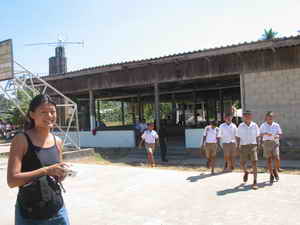Tsunami Orphans in Thailand
Wat Komaneyaket School
Khuk-Khak Villege, Takuapa District, Phang-Nga Province 82190, Thailand
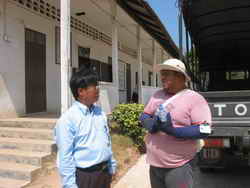 Headmaster (Left), Mr. Suchart Wungwisate, conversed with a Thai volunteer.
Headmaster (Left), Mr. Suchart Wungwisate, conversed with a Thai volunteer.
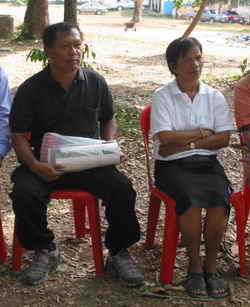
Deputy headmaster, Mr. Songkram and lower school teacher, Mrs. Ratchanee (his wife). Each lost 5 relatives to the Tsunami.
 School's organization chart. There appears only teaching staff but nothing else. It was assumed that either everything else in the school is automatically in place after use and requires no maintenance or the teachers are supposed to do everything themselves.
School's organization chart. There appears only teaching staff but nothing else. It was assumed that either everything else in the school is automatically in place after use and requires no maintenance or the teachers are supposed to do everything themselves.
 .
.
Not because of the Tsunami but the school is underfunded, some classroom has no desks nor chairs. How could they possibly study linear equation without a desk!? Well, it really happens. What you can say.

Hallway of the only building in operation. It houses teaching-staff rooms, a science lab, a computer lab, a language lab, a conference room and a library. However, these facilities are poorly maintained and partially functioned.
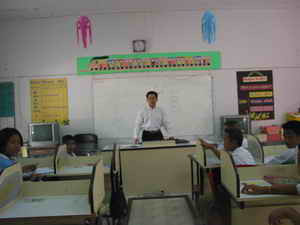
The language lab had been donated for quite
some times but failed to function. Now it serves as a classroom.

Fortunately, the school has a computer lab. Yet, students still has to sit on the floor because there were not enough chairs.
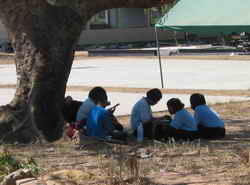
After lunch, students have no place to stay but study under a tree shade.
Getting to Know the SchoolWat Komaneyaket school is a middle school. It has provided basic education to approximately 400 disadvantaged students from fisherman villages and hotel and resort employees in Kaolak area. Since the school is located on a highland in the middle of Kaolak bay, this explains why the school survive the Tsunami waves and why the student casualty is so high. That is, the school remains while the entire area of Bang Sak village just downhill to the north (about 6 square kilametres) was totally wiped out, the entire area of Kaolak hotels and resorts (about 10 square kilometres) just downhill to the south was also totally wiped out, and the newly-openned 200 million baht luxurious resort, Sophitel, next to the school to the west, was gone too.
My first impression with the school was that it's not working. How could it be when
- The school had been understaffed and underfunded. For the former there was just enough teachers, no substitue, no support staff, no clerk, no administration, nor janitors. It was assumed that the only activity required for running a school is teaching. Teachers are supposed to do all the works to keep the school run. If someone got sick, students got no class.
For the latter, the existing buildings are either aged or disfunctional. The wood-made gym was unfit and unsuable. The canteen room was in a poor condition. The only two-storey building was not in use because it could collapsed any time. Therefore, higher class students resorted to study under the tree shades or no the glasses. Then things had changed from worse to worst when the Tsunami struck.
- Some teachers lost their family members. For instance, the deputy headmaster, Mr. Songkram lost 5 relatives: His uncle and a nephew, his younger brother and his wife, and another sister-in-law. At the same time, his wife, Mrs. Ratchanee, a lower school teacher lost 5 relatives as well: Her aunt, her older brother and a brother-in-law, one neice and one nephew. Imagine how chaostic their life would be to find their relative's bodies, to shoulder the burdens of their relatives' families and to take responsibility as a school teacher at the same time.
- Because of the Tsunami, their tasks were immediately doubled or even tripled, since their 22 students died, 13 missings and 53 lost their parents plus a number of the injuried and the panic, they became the first group of volunteers on site who followed up their problems, lent hands and provided support as much as their could. This is quite admirable.- There had been a long line of unfamiliar faces from all quarters: Government officials, guests, volunteers, rescue units, etc., approached the school to help. It was laborous for the teachers to coordinate information and to try to channel aids and assistance to the affected. The duty was almost paramount, especially when they could barely express their affected students' needs in English. Imagine how upset it would be for the out-of-town donors who tried hard to identify the targets and for the potential recipients who really deserved assistance.
Yet, things worked in the sense that they do what they could. And amazingly I hadn't heard any complaints from the teaching staff! How wonderful and how optimistic they were! God blesses them.
Middle school students takes classes under the tree shades not because they are environmentalist it but because there were no classrooms for them. For some classes, students simply sit on the glass.
Behind the Japanese volunteer, the canteen is in poor
condition. There are a few almost-ruined wood tables and benches and is used as an open-aired classroom.
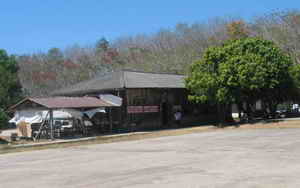
The thirty-plus years old gym is not usable. It cannot even serves as a classroom. Students study under the trees in front the gym. How peaceful and lovely the nature surrounded the gym is!

A student is reading the sign "Ready for Demolition and Reconstruction" at the frontside wall of the only two-storey building of this school. A few years ago, teachers decided to move the classroom to under the trees for fear that the building might collapse at any time. The cars up front belong to a rescue unit.
Students were gathering for a Buddhist ritual. They didn't use the school hall behind because of its lousy condition.
Your comments or inquires are welcome. Contact webmaster.

